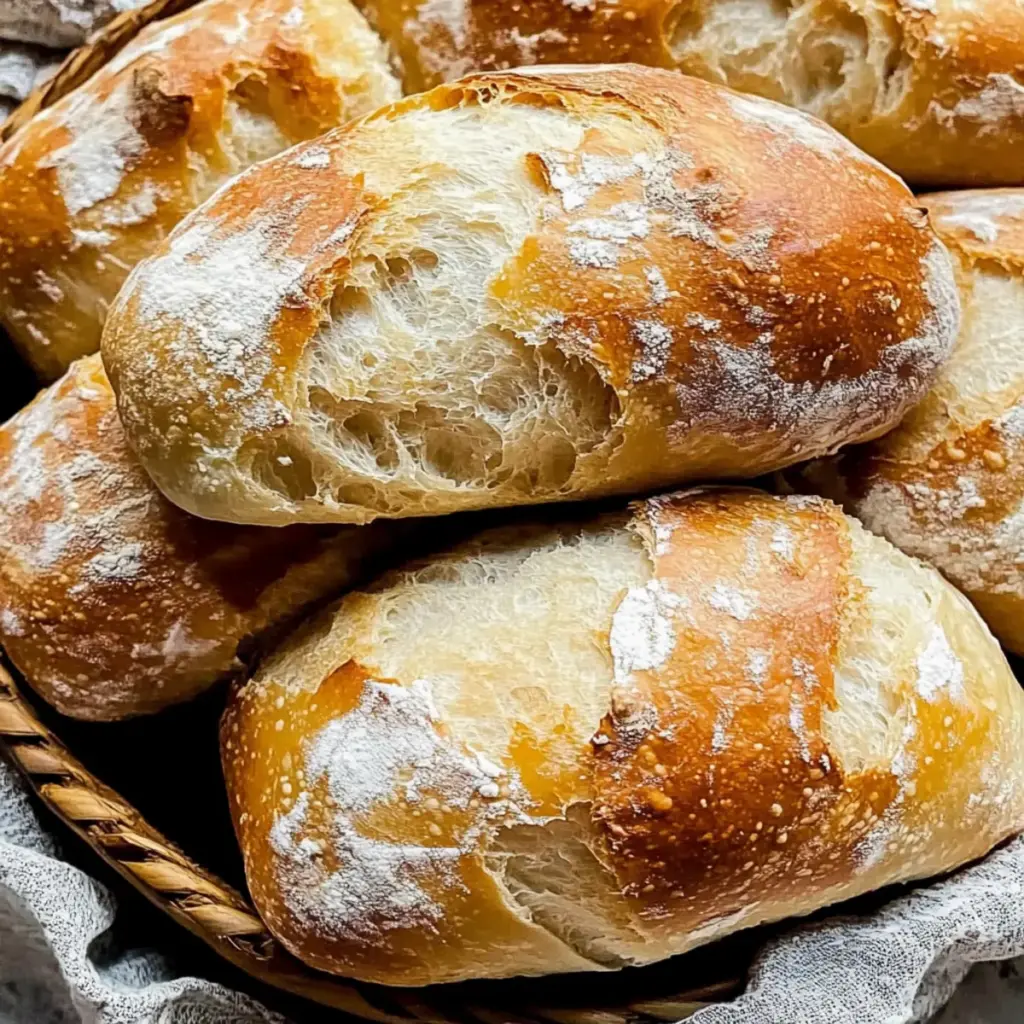The moment I took that first bite of homemade ciabatta bread, the world around me melted away. What’s incredible about this Italian gem is its perfect balance of a crispy crust and a soft, airy interior, bringing the authentic taste of Italy right into your kitchen. Making ciabatta bread at home may sound daunting, but trust me, it’s a straightforward process that even novice bakers can handle with ease. Not only is it a wonderful centerpiece for family dinners and gatherings—it also opens the door to endless sandwich possibilities. Plus, the satisfaction of pulling a freshly baked loaf from the oven is simply unbeatable! Are you ready to dive into creating your own irresistible ciabatta bread? Let’s make some kitchen magic together!
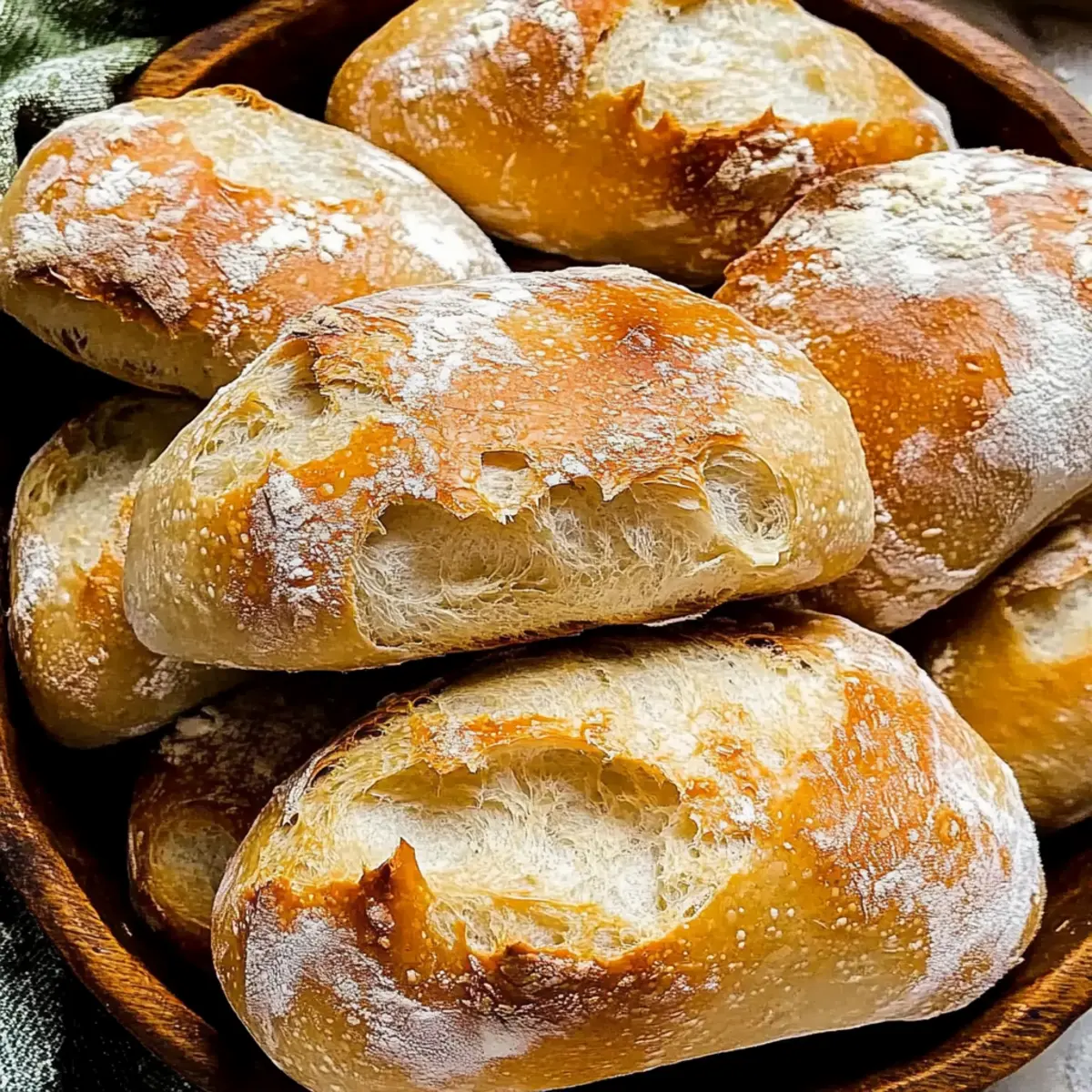
Why Will You Love This Ciabatta?
Irresistible ciabatta bread brings the charms of Italy to your home with ease! Mouthwatering flavor comes from the combination of crusty exterior and soft, airy crumb that makes every bite a delight. Versatile and adaptable, enjoy it as toast, a sandwich, or paired with soups. Quick preparation means you’ll have beautiful loaves without spending all day in the kitchen. Pair it alongside my delicious Soft Gingerbread Cupcakes for a cozy meal, or savor it with a warm bowl of homemade soup—the options are endless!
Ciabatta Bread Ingredients
• To create your own irresistible ciabatta bread, gather these key ingredients for the perfect loaf!
For the Dough
- All-Purpose Flour – Provides structure and texture; substitute with high-protein bread flour for an airier crumb.
- Active Dry Yeast – The magic agent that helps the dough rise; ensure it’s fresh for optimal results.
- Warm Water – Activates the yeast; aim for a temperature around 110°F (43°C) for the best fermentation.
- Coarse Sea Salt – Elevates the flavor of the bread; avoid table salt which can be too strong.
- Olive Oil – Adds moisture and a delightful flavor; optional for drizzling before baking to enhance the crust.
Step‑by‑Step Instructions for Irresistible Ciabatta Bread
Step 1: Prepare the Dough
In a large bowl, combine 4 cups of all-purpose flour and 2¼ teaspoons of active dry yeast. Gradually pour in 1½ cups of warm water, around 110°F (43°C), while stirring to form a shaggy dough. This mixture will be sticky, so embrace that texture as you bring it together. Use a sturdy wooden spoon or your hands for this initial mixing.
Step 2: Knead It Out
Transfer the sticky dough onto a floured surface and knead it for about 10 minutes. As you work the dough, push, fold, and stretch it until it becomes smooth and elastic, an indicator that the gluten has developed properly. Dust with flour as needed to prevent sticking, but be careful not to incorporate too much extra flour into your mixture.
Step 3: Let It Rise
Place the kneaded dough in a lightly oiled bowl, rotating it to coat the surface. Cover the bowl with a damp cloth and let it rise in a warm area for approximately 2 hours. You’ll know it’s ready when the dough has doubled in size—a beautiful puffy dome that invites you to the next step in your ciabatta bread journey.
Step 4: Shape Your Ciabatta
After the dough has risen adequately, punch it down gently to release any air bubbles. Divide the dough into two equal pieces and shape each into a rectangular loaf, being careful to maintain some of the airiness within. Place each loaf on a floured surface and stretch them gently to create those signature ciabatta shapes, ready for their next rise.
Step 5: Second Rise
Transfer the shaped loaves onto parchment-lined baking sheets, giving them ample space. Cover them loosely with a cloth and let them rise for another hour. This second rise is crucial for achieving the delightful texture of your ciabatta bread, so be patient as the loaves puff up and become airy once more.
Step 6: Bake It Up
Preheat your oven to 450°F (230°C) while your loaves finish their rise. Just before placing them in the oven, drizzle the tops with olive oil and sprinkle with coarse sea salt for that beautiful crust. Bake the loaves for 25-30 minutes until they are golden brown and sound hollow when tapped on the bottom. This marks the moment when you’ll truly appreciate the magic of homemade ciabatta bread!
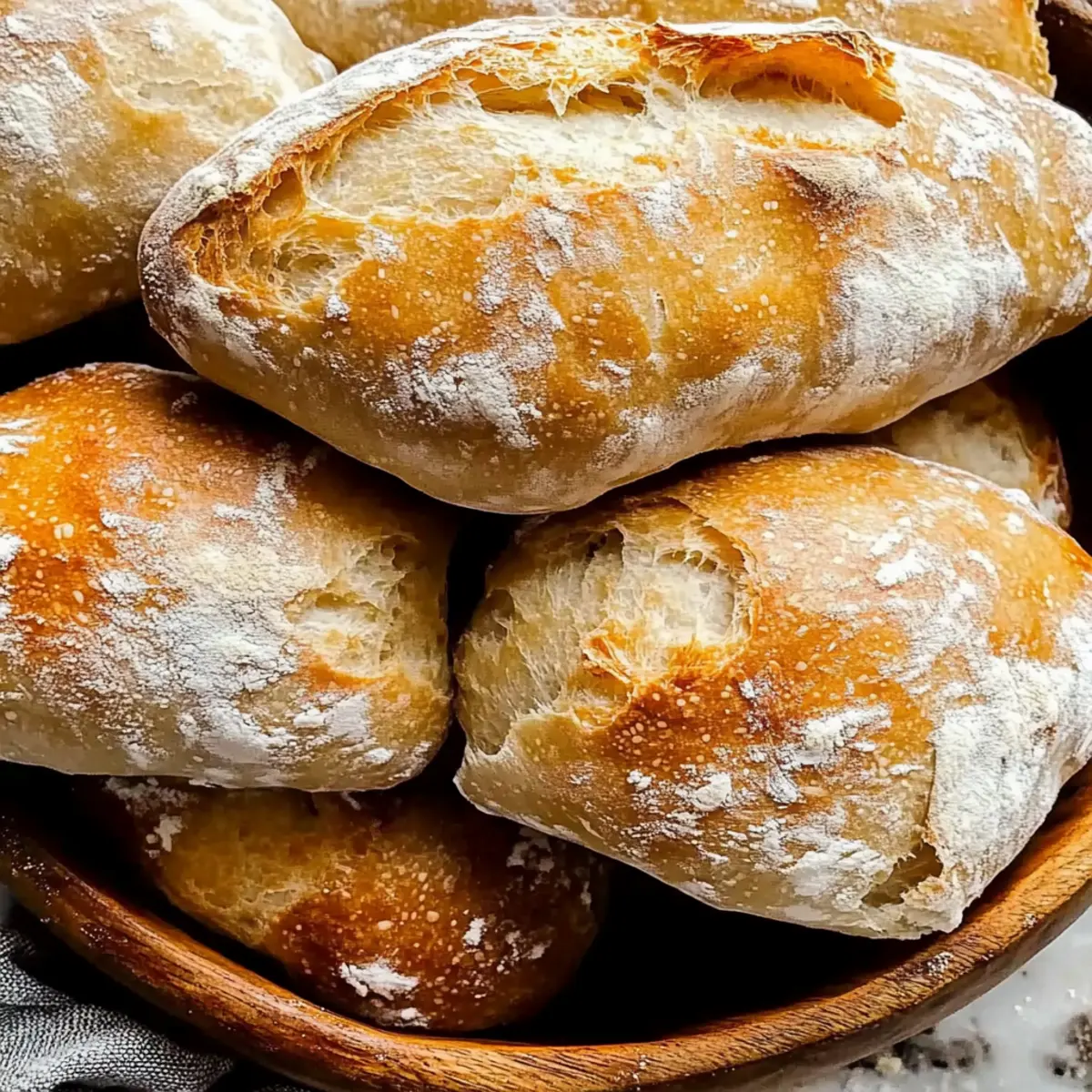
Expert Tips for Perfect Ciabatta Bread
-
Use High-Protein Flour: Opt for high-protein bread flour or “00” flour to achieve that iconic chewy texture ciabatta is known for.
-
Check Your Yeast: Ensure your active dry yeast is fresh and bubbly. Old yeast won’t rise your dough properly, leading to dense bread.
-
Be Patient with Rises: Allow ample time for both the first and second rises. Rushing this step can impede the light and airy texture of your ciabatta.
-
Avoid Over-Kneading: Knead just until smooth and elastic. Over-kneading can lead to tough bread instead of the desired soft and airy crumb.
-
Experiment with Add-ins: Consider mixing in dried herbs or sun-dried tomatoes during the kneading process for a flavorful twist on traditional ciabatta bread.
How to Store and Freeze Ciabatta Bread
-
Room Temperature: Store your ciabatta bread in a paper bag at room temperature for up to 3 days to keep its crust crispy while maintaining softness.
-
Freezer: For longer storage, freeze slices of ciabatta bread. Place them in an airtight container or freezer bag, and they’ll keep well for up to 3 months.
-
Thawing: To enjoy your frozen ciabatta, simply thaw slices at room temperature or warm them in a preheated oven for a few minutes. This restores the crust’s delightful crunch.
-
Reheating: If you prefer a warm ciabatta, reheat it in the oven at 350°F (175°C) for about 10 minutes, ensuring you’ll enjoy that freshly baked taste again.
Ciabatta Bread Variations & Substitutions
Feel free to customize your ciabatta bread to suit your taste buds and dietary needs. Let your creativity shine in the kitchen!
-
Herb-Infused:
Mix in chopped fresh herbs like rosemary or thyme for a fragrant twist. This small addition can turn your bread into a delightful aromatic experience. -
Mediterranean Delight:
Add olives or sun-dried tomatoes to the dough for a burst of flavor and added texture. These ingredients bring a taste of the Mediterranean to each slice, making it perfect for serving at gatherings. -
Whole Wheat Version:
Swap half of the all-purpose flour with whole wheat flour for a nuttier flavor and a nutritional boost. The result is a heartier loaf that retains the lightness of ciabatta while enhancing its health benefits. -
Cheesy Goodness:
Stir in grated Parmesan or Asiago cheese directly into the dough for a cheesy delight. Each bite will offer savory flavors that elevate your ciabatta to gourmet levels. -
Spicy Kick:
Incorporate crushed red pepper flakes or diced jalapeños for added heat. Perfect for those who enjoy a spicy twist on their traditional bread. -
Vegan Substitution:
Replace the olive oil with a neutral vegetable oil if you’re looking for a vegan option. The texture and flavor will remain delightful and satisfying. -
Flavorful Flours:
Use alternative flours like spelt or rye for unique flavor profiles. Each flour brings its own character, transforming your ciabatta into a special creation that tastes just like Italy. -
Dijon Surprise:
A tablespoon of Dijon mustard mixed into the dough can add a subtle tang. This small change adds depth to the flavor without overwhelming the classic ciabatta essence.
Feel inspired to experiment and enjoy every bite of your homemade bread! Pair your delicious ciabatta with a bowl of hearty soup or indulge your sweet tooth with my Soft Gingerbread Cupcakes for a comforting meal.
Make Ahead Options
These irresistible ciabatta bread loaves are perfect for meal prep enthusiasts! You can prepare the dough and let it rise for the first time up to 24 hours in advance; simply refrigerate it in an oiled bowl covered with plastic wrap to prevent drying out. For the best quality, shape the dough and perform the second rise on the day you plan to bake. When ready to serve, just bake for 25-30 minutes until golden brown. This way, you’ll enjoy fresh, homemade ciabatta bread with minimal effort, making busy weeknights so much easier while still delighting your family with that restaurant-quality taste!
What to Serve with Irresistible Ciabatta Bread
Creating the perfect serving spread elevates your freshly baked ciabatta from delicious to unforgettable! Picture a warm loaf sitting on the table, surrounded by delightful accompaniments.
-
Savory Tomato Basil Soup: The bright acidity and rich flavors of this classic soup create a match made in heaven, perfect for soaking up ciabatta’s crusty goodness. A bowl of comforting soup alongside your bread makes for a heartwarming meal.
-
Garlic Herb Butter: Spread this velvety blend on warm slices for an extra layer of flavor; the aromatic butter melts beautifully into the airy crumb, enhancing every bite. Serve it on the side for a delightful dipping experience!
-
Arugula Salad with Lemon Vinaigrette: The peppery freshness of arugula paired with zesty lemon vinaigrette cuts through the bread’s richness, creating a refreshing balance. This salad is an excellent palate cleanser and adds a pop of color to your meal.
-
Prosciutto and Fig Spread: This sweet and savory combination is sublime! The salty prosciutto gives a delightful contrast to the sweet fig spread, perfect for crafting delicious sandwiches on ciabatta or enjoying as a tantalizing appetizer.
-
Caprese Salad Skewers: Juicy cherry tomatoes, fresh mozzarella, and fragrant basil drizzled with balsamic glaze provide a refreshing bite. Pair these skewers with your ciabatta for impressive and vibrant finger food.
-
Red Wine: A hearty red wine, like Chianti or Sangiovese, complements the rustic flavors of ciabatta perfectly, enhancing the warmth and richness of your meal. It’s a comforting choice that brings everything together.
-
Hummus and Veggies: Enjoy creamy hummus with sliced cucumbers, bell peppers, and carrots for a vibrant appetizer. The contrast of crunchy veggies and soft bread makes for a delightful texture experience.
-
Cheese Platter: Curate a selection of cheeses, such as aged cheddar, creamy brie, and tangy goat cheese, to enjoy with your ciabatta. The variety of flavors and textures create an enticing cheese board perfect for sharing.
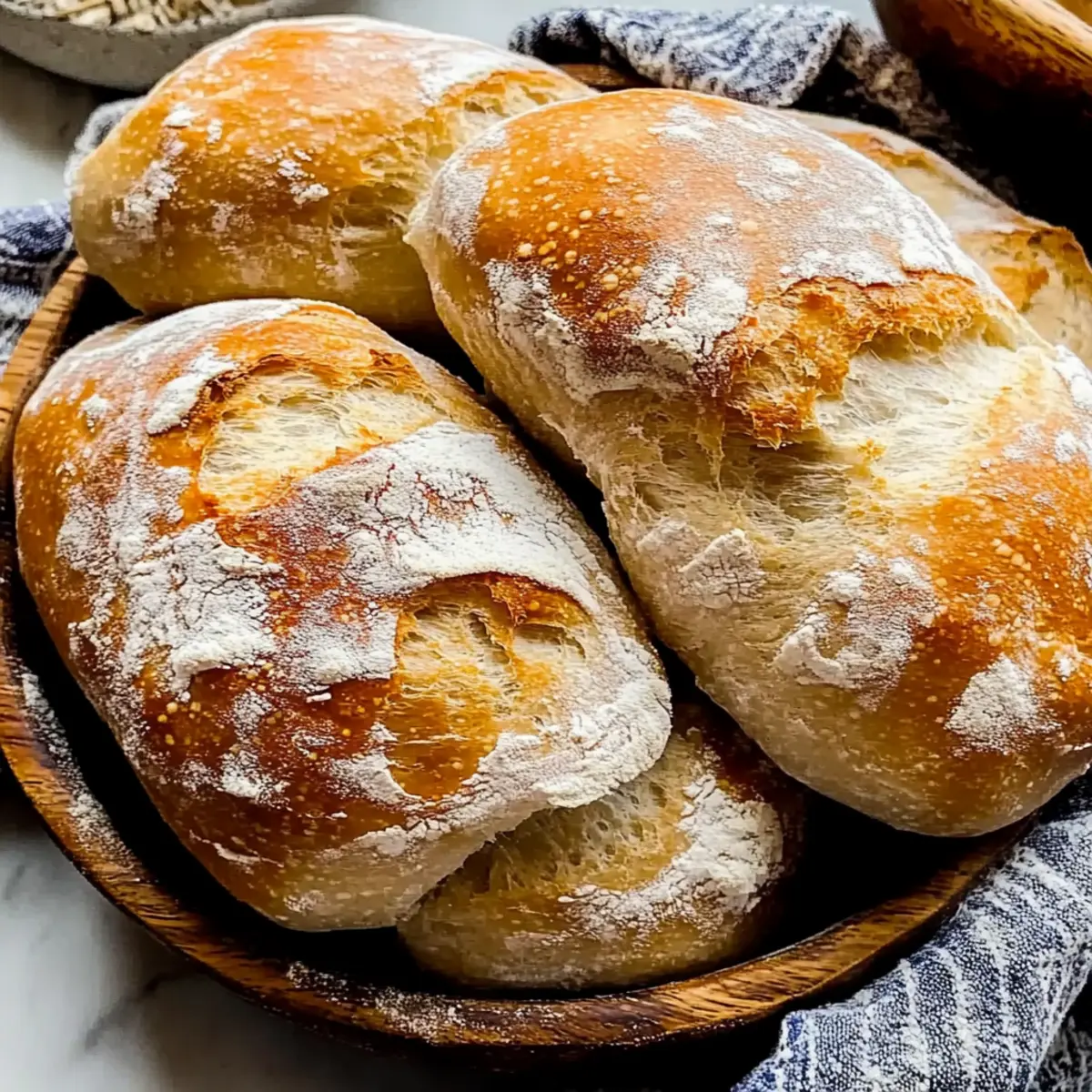
Ciabatta Bread Recipe FAQs
How do I choose the right flour for ciabatta bread?
Using high-protein flour is key for achieving that chewy texture ciabatta is celebrated for. Opt for bread flour or Italian “00” flour, which is finely milled and perfectly suited for artisan breads. If you only have all-purpose flour on hand, that works too, but you may miss out on the airy and light quality of a true ciabatta.
What is the best way to store homemade ciabatta bread?
To maintain its freshness, store your ciabatta bread in a paper bag at room temperature for up to 3 days. This allows air circulation, helping to keep the crust crispy. If you want to keep it longer, freeze the bread; just wrap slices tightly in plastic wrap and place them in a freezer-safe bag. They can last up to 3 months this way.
Can I freeze ciabatta bread? If so, how?
Absolutely! To freeze your ciabatta, slice the cooled loaf and place the pieces into an airtight container or a freezer bag. Be sure to remove as much air as possible to prevent freezer burn. When you’re ready to enjoy them, you can let the slices thaw at room temperature or pop them into a preheated oven at 350°F (175°C) for about 10 minutes to revive their crusty texture.
Advertisement
What should I do if my ciabatta doesn’t rise?
If your ciabatta does not rise as expected, this could indicate that your yeast is inactive—check the expiration date! Ensure that your warm water is at the right temperature (around 110°F or 43°C) and not too hot, as that can kill the yeast. For troubleshooting, allow the dough more time to rise in a warm, draft-free area; sometimes, patience is all that’s required to achieve that lovely puffiness.
Are there any dietary considerations for ciabatta bread?
If you’re making ciabatta bread for guests with dietary restrictions, be mindful that it contains gluten from the flour. For those with gluten sensitivities or Celiac disease, I recommend exploring gluten-free bread alternatives. Additionally, pay attention to the olive oil; if replacing, opt for a suitable alternative oil that will not alter the flavor too much, like avocado oil or grapeseed oil.
Can I add flavors or ingredients to my ciabatta dough?
Very much so! I often enhance my ciabatta by kneading in chopped fresh herbs like rosemary or thyme, or even sun-dried tomatoes and olives for a twist. Just ensure to adjust your kneading time accordingly to incorporate these additions and maintain that classic airy crumb. Get creative!
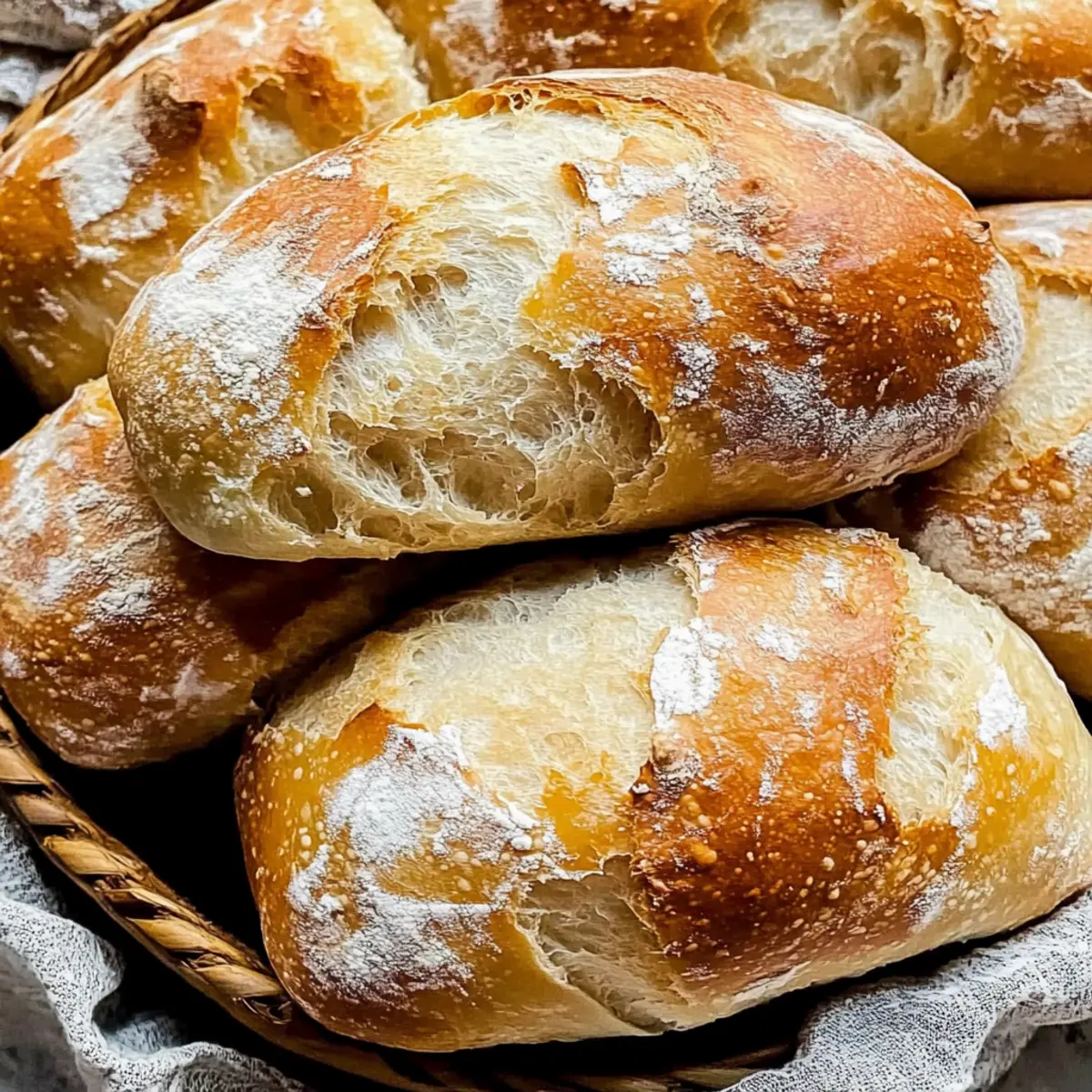
Perfectly Crispy Ciabatta Bread You Can’t Resist
Ingredients
Equipment
Method
- In a large bowl, combine 4 cups of all-purpose flour and 2¼ teaspoons of active dry yeast. Gradually pour in 1½ cups of warm water, stirring to form a shaggy dough.
- Transfer the sticky dough onto a floured surface and knead it for about 10 minutes until smooth and elastic.
- Place the kneaded dough in a lightly oiled bowl, cover with a damp cloth, and let it rise in a warm area for approximately 2 hours.
- After the dough has risen, punch it down gently, divide into two equal pieces, and shape into rectangular loaves.
- Transfer the shaped loaves onto parchment-lined baking sheets, cover loosely, and let them rise for another hour.
- Preheat your oven to 450°F (230°C). Drizzle the loaves with olive oil and sprinkle with coarse sea salt, then bake for 25-30 minutes.

